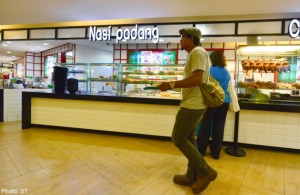A boy of four who died after contracting Salmonella did not necessarily get it from a nasi padang stall where his mother bought food, a court heard.
 At a further inquest into the death of Shayne Sujith Balasubraamaniam on Jan 22 last year, State Coroner Marvin Bay found that it was only a “likelihood” that he contracted the infection from food consumed at the stall.
At a further inquest into the death of Shayne Sujith Balasubraamaniam on Jan 22 last year, State Coroner Marvin Bay found that it was only a “likelihood” that he contracted the infection from food consumed at the stall.
He, his mother and two- year-old sister suffered fever, diarrhoea and vomiting on Jan 19, a day after eating food bought from Kopitiam food court in Northpoint shopping centre.
His mother had bought home tahu goreng for him, and rice, chicken curry and bergedil (potato cutlets) for the three of them on Jan 18.
All three were taken to a polyclinic where Shayne was assessed to be severely dehydrated and prescribed medication.
He showed signs of recovery on Jan 21 but his condition worsened the next day. The cause of death was primarily consistent with salmonella septicaemia.
Two days later, the implicated food stall was inspected and found to have hygiene lapses.
The stallholder, Madam Siti Abibah Guno, was fined a total of $1,400 last month for failing to register a food handler, and protect food in a covered receptacle.
She has since cancelled her foodstall licence after Kopitiam terminated her tenancy agreement in November.
Recalled to the stand yesterday, Dr Hishamuddin Badaruddin, assistant director at the Health Ministry’s Communicable Diseases Division, could not conclude 100 per cent that the source of infection was the nasi padang stall.
The further hearing was held as the State wanted the court to clarify the coroner’s phrasing last October that it was “highly likely” the family had contracted the infection from the stall.
At the last hearing, Dr Hishamuddin had said lapses such as the way food was prepared could have contributed to bacterial growth, particularly the practice of partial cooking and refreezing of chicken parts.
He testified yesterday that the results of environmental swabs showed no salmonella in the stall nor in the food samples taken.
While there was salmonella bacteria found in the three family members, there was nothing else to link it to the stall.
He agreed with State Counsel Zhou Yihong, who assisted in the inquiry, that although he used the word “likely”, this likelihood of bacteria found in the cases was actually quite low.
“In my field, the word likely is not the same as the layman term of likely,” he said.
 Initial reports said that about 130 people were known to have become ill after consuming food from the caterer, but a total of 231 are now linked to the case.
Initial reports said that about 130 people were known to have become ill after consuming food from the caterer, but a total of 231 are now linked to the case.






 Rojak is a fruit and vegetable salad dish
Rojak is a fruit and vegetable salad dish The banana leaves are usually wiped with a damp cloth before being used to serve food on.
The banana leaves are usually wiped with a damp cloth before being used to serve food on.